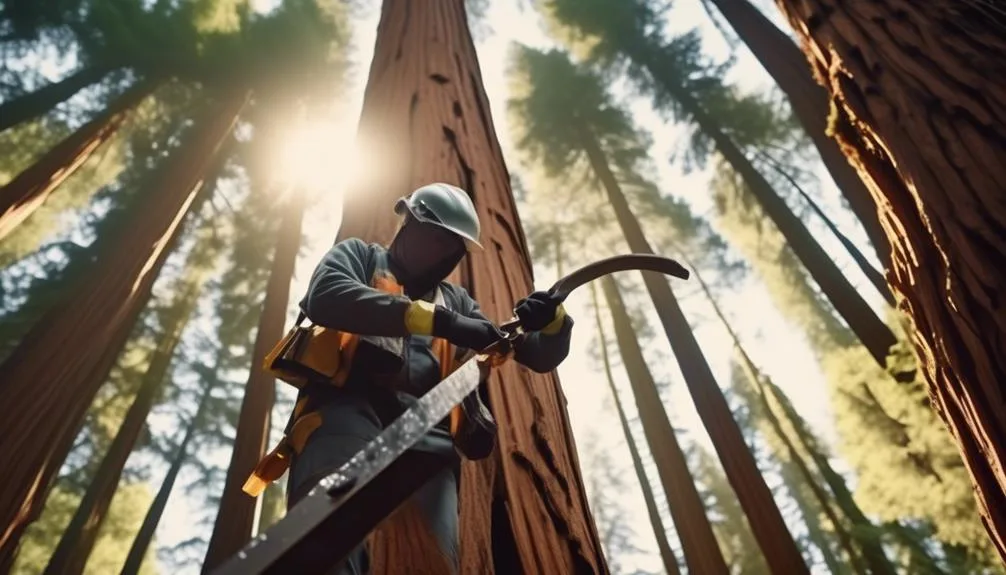Redwood trees are a favorite among homeowners for their impressive height and beauty. The coastal redwood is the tallest tree species on Earth, reaching over 300 feet. Pruning these giants may seem challenging, but with the right knowledge, you can keep them healthy and attractive.
Whether you're new to gardening or an experienced enthusiast, understanding how to prune redwood trees is crucial. Let's delve into the essential factors and expert tips for maintaining these iconic trees.
Timing of Pruning Redwood Trees
To ensure the health and vitality of your redwood trees, it's crucial to prune them at the appropriate times during their growth cycle. The best practices for timing pruning involve considering the season and the tree's specific needs.
In late winter or early spring, when the tree is dormant, is the optimal time for major pruning. This allows the tree to heal before the growing season begins.
Minor shaping and maintenance pruning can be done in the summer months, but it's essential to avoid heavy pruning during this time, as it can stress the tree.
Avoid pruning in the fall, as the wounds may not have sufficient time to heal before winter.
Understanding the seasonal considerations for pruning techniques will help maintain the health and aesthetics of your redwood trees.
Selecting the Right Tools for Pruning
Selecting the right tools for pruning your redwood trees is crucial for achieving clean cuts and promoting tree health. Here are some essential tools and safety precautions to keep in mind:
- Pruning Shears: Choose a sharp pair of bypass pruning shears for cutting small branches and foliage without causing damage to the tree.
- Loppers: Opt for loppers with long handles to reach higher branches and thick stems, ensuring clean and precise cuts.
- Pruning Saw: A sharp pruning saw is essential for removing larger branches with ease and precision.
- Safety Gear: Prioritize safety by wearing gloves, safety goggles, and sturdy footwear to protect yourself from potential hazards.
Understanding Redwood Tree Growth Habits
Understanding the growth habits of redwood trees is essential for effectively managing their health and appearance.
Redwood trees are known for their rapid growth and towering heights, which makes it crucial to stay on top of redwood tree maintenance.
These trees have a unique growth pattern, with branches often growing in a spiral arrangement around the trunk. This growth habit requires careful consideration when applying proper pruning techniques to maintain the tree's structural integrity.
Redwood tree care should also take into account their ability to regenerate from old growth, making it important to understand how and where to make pruning cuts.
Techniques for Pruning Redwood Trees
Consider using sharp pruning shears to make clean cuts when pruning redwood trees, ensuring the health and vitality of the tree. When pruning redwood trees, it's important to follow proper techniques to promote healthy growth and maintain the tree's natural beauty.
Here are some key pruning methods to keep in mind:
- Selective Pruning: Identify and remove dead, diseased, or crossing branches to improve overall branch structure.
- Crown Thinning: Remove some interior branches to increase sunlight penetration and air circulation within the tree canopy.
- Top Pruning: Trim the top of the tree to manage its height and encourage lateral growth.
- Regular Maintenance: Schedule routine pruning to maintain tree health and prevent potential hazards.
Pruning benefits the redwood tree by promoting strong branch structure, reducing the risk of disease, and maintaining overall tree health.
Common Mistakes to Avoid When Pruning
To ensure successful pruning of redwood trees, it's crucial to avoid common mistakes that can negatively impact the tree's health and appearance.
One common mistake to avoid is making improper cuts. This includes leaving behind stubs or cutting too close to the trunk, which can lead to decay and disease. When pruning, always make clean cuts just outside the branch collar to promote proper healing.
Another mistake to steer clear of is over pruning. While it's important to remove dead or diseased branches, excessive pruning can stress the tree and hinder its growth. Over pruning can also leave the tree vulnerable to pests and diseases.
Conclusion
In summary, pruning redwood trees with care and attention to timing, tools, and techniques is vital for their long-term health and beauty. Avoiding common mistakes and understanding their growth patterns are key.
By doing so, you can nurture the vitality of your redwood trees for years to come.
Happy pruning for healthy, thriving redwoods!
Mark Hoffman is a dedicated arborist and tree care specialist with over a decade of experience. His love for trees began when he visited Yosemite National Park as a teenager and was awestruck by the giant sequoias. Mark pursued his passion by studying forestry at Michigan Technological University, where he earned a Bachelor of Science degree.
Since then, he has worked tirelessly in the field of arboriculture, helping to preserve and protect trees in his community. His expertise and dedication have made him a respected leader in the industry and a valuable resource for anyone seeking advice on tree care.
